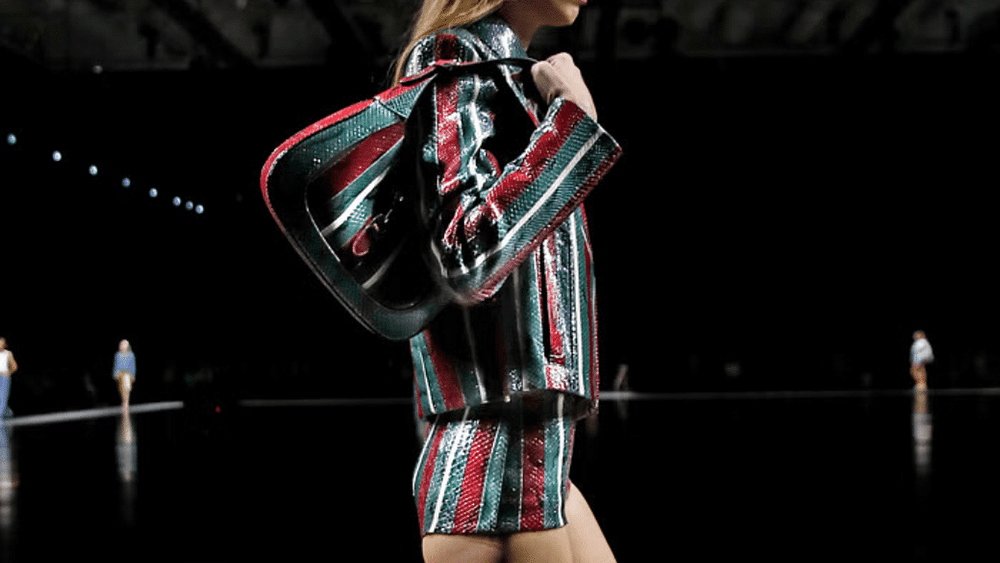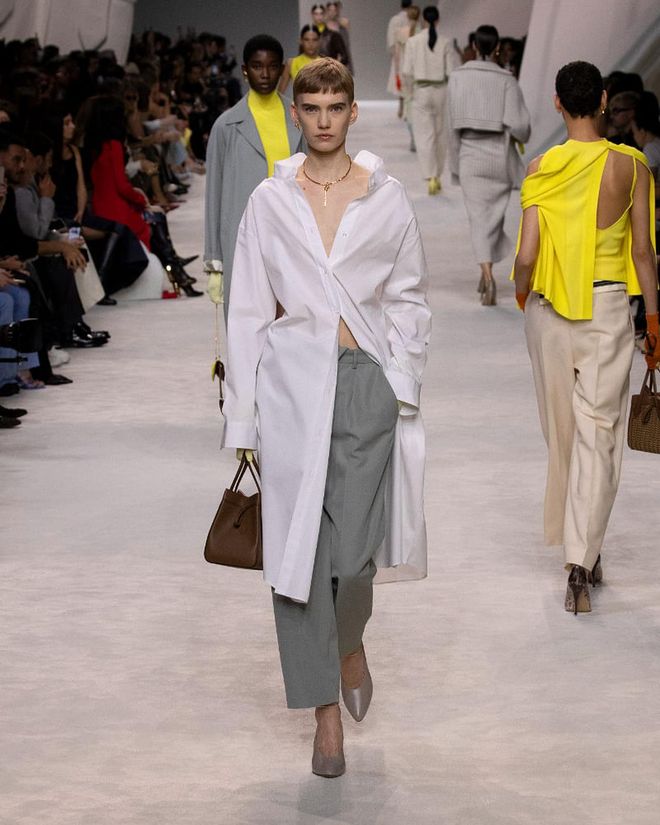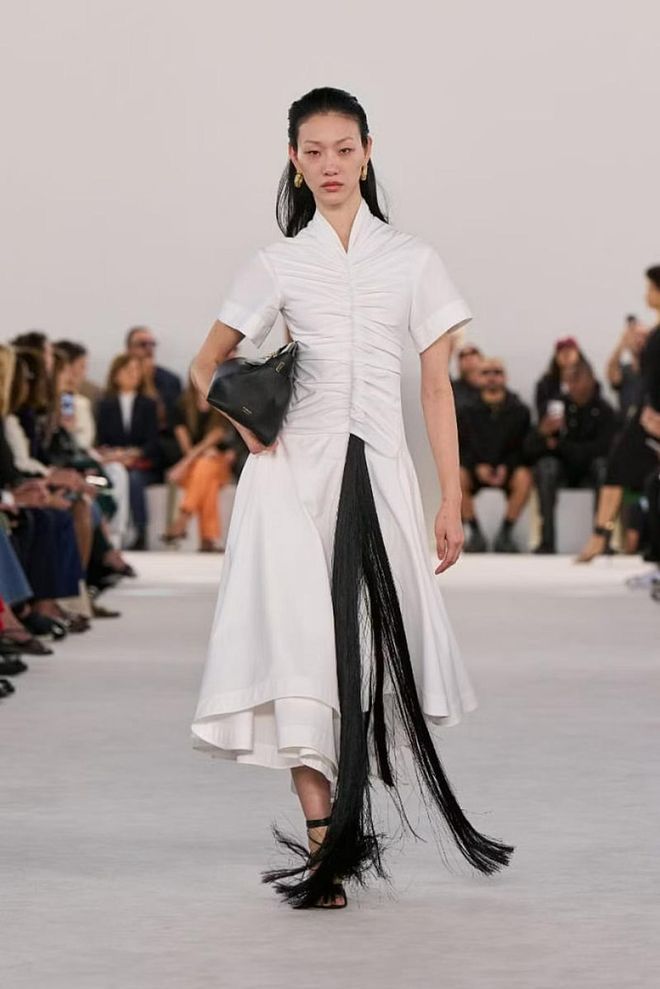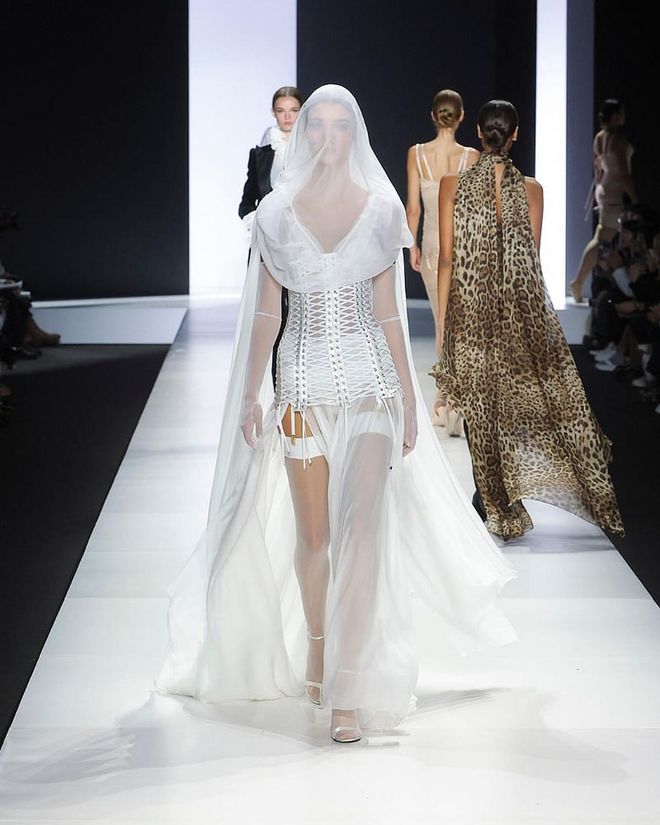At Milan Fashion Week, Heritage Found A New Expression
How today’s designers balanced looking back and forging ahead.

Many heritage fashion brands have been in a state of existential crisis over the last several years. And while some established houses did well during the most recent wave of collective nostalgia by returning to the recognisable faces, bags, logos, and silhouettes they are best known for, you can’t look back forever. With several new or newish creative directors in charge, it has felt like time to take a big step forward and create real synergy between the past, present, and future. This season at Milan Fashion Week, that finally happened.
Related article: Milan Men’s Fashion Week: 7 Trends To Watch For Fall/Winter 2023

Photo: Fendi
Fendi SS24
As artistic director of womenswear at Fendi, the skillful Kim Jones has paid homage to the brand’s legacy—last September, the fashion house celebrated the 25th anniversary of the Baguette with a blockbuster runway show in New York, and in February the designer’s subdued, streamlined, and classic collection referenced work from his predecessor, the iconic Karl Lagerfeld, in the ’90s.
This season, Jones continued in that vein, drawing inspiration from Lagerfeld’s Spring/Summer 1999 collection for the house, but also created something that was his own. The Spring 2024 collection was elevated and elegant without any pomp or pointedness. These were ladylike clothes and accessories, but made for someone who lives on the Upper East Side or in the Brera circa now, not before the start of the millennium.
As Jones wrote in his show notes, the collection was a nod to the women he sees on the streets when he is working in Rome, women who believe that getting dressed is “not about the spectacle of being looked at but the reality of wearing and the confidence and chicness that comes with it.” Models wore short, sheer gloves with a barely visible Fendi logo, many carrying elegant clutches at mid-waist height. The knits were the standouts, color-blocked in bright orange and soft pastel blue, while trousers with deconstructed waistbands created a soft, body-hugging silhouette. The dresses were lovely and wearable, as were the oversize car coats and white shirting.
If many showgoers and viewers alike could see themselves in the collection, that was exactly the point. As Jones explained: “It’s not about being something but being someone.”

Photo: @maxmara
The purity of dressing for oneself extended to Max Mara’s spring offering. As a starting point, creative director Ian Griffiths looked to the Women’s Land Army, an organization that was formed in WWI but went into action during WWII, taking on the farming in Britain while the men went to war. While utility and strength were certainly present in this collection, the pieces were also refined and feminine–both in styling and choice of materials.
Wildly covetable work jackets were cut perfectly from canvas cotton, as were the jumpsuits, one of which was belted in a royal blue, a color that paid homage to the late, great photographer Bill Cunningham. Griffiths also made popped collars look cool again, some worn beneath perfectly nubby knits or easy bomber jackets. These were clothes you just really want to own and wear and keep forever, pieces that could be integrated into anyone’s closet and look spectacular.
At Ferragamo, Maximilian Davis also achieved wardrobe bliss (and then some) with a beautiful collection, his third as the brand’s creative director. Backstage, Davis remarked that his first outings for the house were really about “making sure the heritage is still there” but also that “now we’re in a position to experiment and have fun.” It was clear that he’s achieved his groove at Ferragamo, integrating his sense of fluid, modern design into one of the oldest brands in Italy. You could see it in the billowy dresses with color-blocked, dripping blob-esque motifs running down the front; in his suiting and shirting, in which sleeves were slit down the arm and worn hanging down at the sides; and in the variety of silhouettes, from short shorts to cropped trousers to floor-grazing gowns.
Davis played with texture too, most impressively by way of an oversize belt woven with small black and white discs. He also honored the Ferragamo codes, namely via the collection’s palette and the accessories. But where he gave us a more classic shoe or bag, he also presented carryalls that came with one handle and multiple zippers or were oblong in shape. Davis is doing his thing, even more than before, and the results are something we should keep watching—and keep wanting.

Photo: Ferragamo
Related article: The Best Street Style From Milan Fashion Week
On the “quiet luxury” front, Tod’s provided a zenlike juxtaposition to its louder Italian counterparts. It was creative director Walter Chiapponi’s last show for the house, and he delivered a collection that was both lovely and precise in its execution.
On the other end of the luxury spectrum were the heritage labels who love a show. Whether it was the debut of Peter Hawkings at Tom Ford or Moschino’s dance-infused, stylist-made 40th anniversary extravaganza (they’re still without a creative head following the departure of Jeremy Scott), there was a cadre of theatrical runways this season in Milan. Whereas Tom Ford and Moschino celebrated their pasts in a much more literal and pure fun way, Versace and Dolce & Gabbana provided thoughtful references to their ’90s archives, something they’ve been quite successful with over the last few years.

Photo: @versace
At Versace, Donatella Versace gave us mod style à la Gianni—she sweetly referenced his Fall 1995 collection of checked minis and sets for a collection that did feel pretty perfect for the now. And at Dolce & Gabanna, there were nods to Saint Laurent’s Le Smoking jackets, but sexed up with ’90s-esque lingerie looks done in the house’s signature style.
Of course there were the viral moments for both: At Versace, it was Natalia Bryant and Claudia Schiffer walking the runway; and at Dolce, it was Naomi Campbell closing the show, almost making up for the fact that guests waited nearly an hour for Kylie Jenner to turn up so things could start.

Photo: @dolcegabbana
Despite these Instagrammable fashion happenings, as well as the much-discussed debuts at Tom Ford and Gucci, another newsworthy moment flew a little further under the radar this week, with the beginning of Simone Bellotti’s position as design director of Bally. A 16-year veteran of Gucci, he has been tasked with putting the Swiss heritage brand on a new path after it has struggled for years to find the right direction—and the right designer.
It seems like Bellotti may indeed be the man for the job, as his collection not only felt fresh but also had real cool factor. The prep-adjacent, playful clothes, like a draped blossom-style miniskirt paired with a black leather trench coat, were wildly covetable. So too were the studded Mary Jane flats and the classic crossbodies decorated with mini cowbells.
The collection, according to Bellotti, was inspired by the hippie freedoms felt at the Monte Verità community in the canton of Ticino—a bucolic setting where many artists and philosophers came to chill out and dance in the sun. As he said post-show, “Swiss products are very well made, rational, very controlled, and sober. I wanted to add to this story, to add a bit more of a touch of the organic.”
Related article: Forward Leap: The New Guard Of Designers Turning Up The Heat In Milan
He says he views Bally as another Monte Verità, a place where he finds balance between something precise and something more free. “I see a brand as a person,” he noted, which, generally speaking, is key to achieving that balance between old-school heritage fashion and a new, more provocative proposition. “We all have different layers and we all aren’t living in one way.” Thanks to Bellotti and other forward-thinking designers at Milan Fashion Week, we won’t be dressing like it either.
This article originally appeared in Harper’s BAZAAR US.